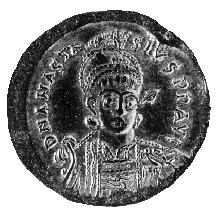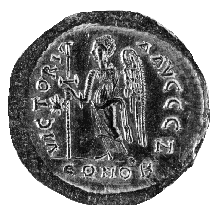



(130) Anastasius I - AV solidus, A.D. 491-518, 4.43
g. (inv. 91.268).
Obverse: Helmeted and cuirassed bust of Anastasius three-quarter
r., holding spear behind head in r.; shield with attacking horseman at l.
shoulder; D(OMINVS) N(OSTER) ANASTASIVS P(ER)P(ETVVS) AVC(VSTVS): Our lord
Anastasius, perpetual Augustus.
Reverse: Victoria standing l., holding long cross in r.;
star in r. field; VICTORIA AVCCC (AVGVSTORVM abbreviated) N: Victory of
the Augusti, officina mark N; CONOB in exergue: gold of Constantinople.
Provenance: Coin Galleries, 1959.
Bibliography: P. Grierson, Byzantine Coins (London
1982).
In A.D. 491, after the death of the emperor Zeno, the empress Ariadne put
the relatively unknown court official Anastasius on the throne. He is best
known for his reform of the copper of the old Roman monetary system, and
for this reason his coins are the first to be considered truly Byzantine.
In contrast to the typical profile portraits of the emperor on the obverses
of coins in the western Roman empire, the Byzantines preferred facing busts.
This coin depicts the military type, with the emperor wearing a cuirass
and helmet, carrying a spear over his right shoulder and a shield at his
left depicting a horseman in battle. The portrait also differs from typical
Western portraits in the extreme simplification of the facial features,
with emphasis upon the large eyes.
The reverse of this coin is one of the last to use partly pagan and partly
Christian imagery. The winged Victoria is a standard type in earlier Roman
coins, but the Victoria on this coin holds a staff with the Christogram,
the monogram of Christ or Xristow in Greek. On this coin the monogram consists
of a cross with a loop at the top forming the Greek letter rho (). The legend
on the reverse is abbreviated in the manner of coins of the late fourth
and early fifth centuries, in which the number of C's (G in this period
takes the form of C) corresponded to the number of emperors ruling together.
In this period there is usually only a single emperor, but the abbreviation
of the plural Augustorum persists. The term CONOB in the exergue
combines CON as an abbreviation for Constantinople with OB, an abbreviation
for obryzum, the technical term for gold.
T.S.R.



All contents copyright (c) 1996.
Lawrence University
All rights reserved.